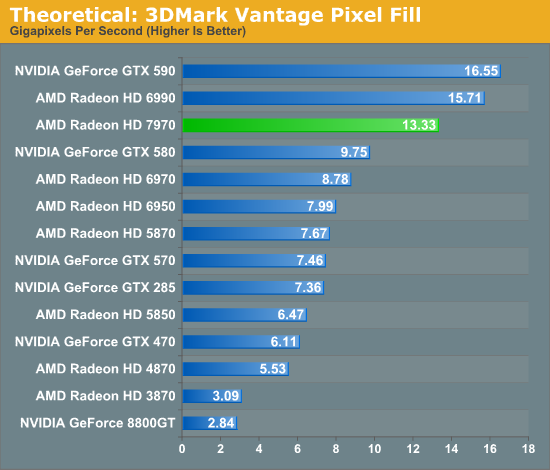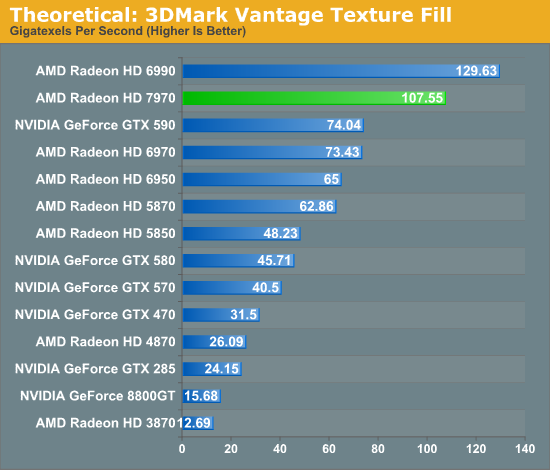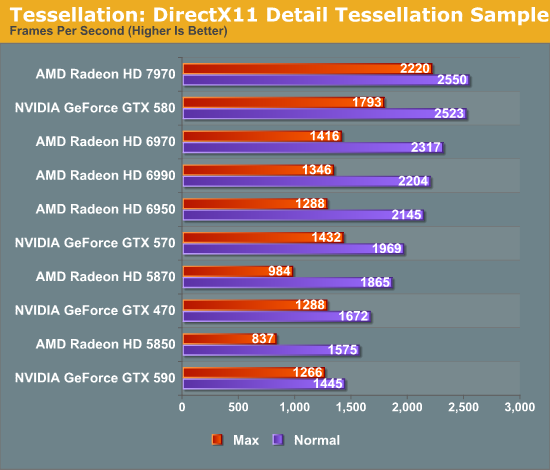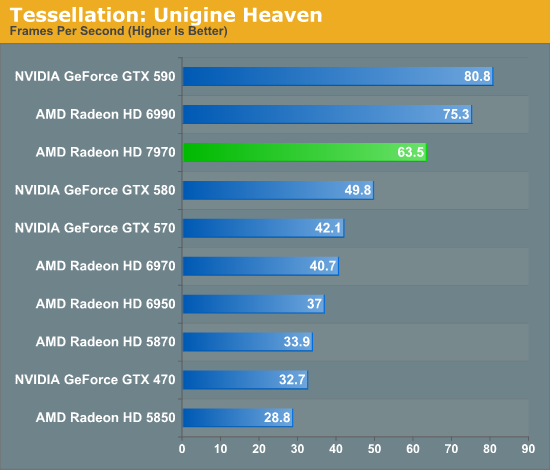AMD Radeon HD 7970 Review: 28nm And Graphics Core Next, Together As One
by Ryan Smith on December 22, 2011 12:00 AM EST- Posted in
- GPUs
- AMD
- Radeon
- ATI
- Radeon HD 7000
Theoreticals & Tessellation
From a rendering perspective one of the most interesting things AMD did with Tahiti was what they didn’t do: they didn’t add more ROPs, they didn’t add more geometry engines. And yet based on our game performance they’ve clearly improved on their performance in those situations by making more efficient use of the hardware they do have.
So we wanted to take a quick look at synthetic performance to see what these tools had to say about AMD’s changes. We’ve included the numbers for every other GPU in our lineup as a reference point, but we would strongly suggest against reading into them too much. AMD versus AMD is sometimes relevant to real world performance; AMD versus NVIDIA rarely is.

We’ll start with 3DMark Vantage and its color fill test. This is basically a ROP test that attempts to have a GPU’s ROPs blend as many pixels as it can. Theoretically AMD can do 32 color operations per clock on Tahiti, which at 925MHz for 7970 means the theoretical limit is 29.6Gpix/sec; not that any architecture is ever that efficient. In practice 7970 hits 13.33Gpix/sec, which is still well short of the theoretical maximum, but pay close attention to 7970’s performance relative to 6970. Even with the same number of ROPs and a similar theoretical performance limit (29.6 vs 28.16), 7970 is pushing 51% more pixels than 6970 is.
In designing Tahiti AMD said that they didn’t need more ROPs they just needed more efficient ROPs, and it looks like they’ve delivered on this. It’s not clear whether this is the limit for efficiency or if AMD can squeeze more out of their ROPs in future designs, but this definitely helps to prove that there’s more to graphics rendering than a large number of functional units.

Our other 3DMark synthetic benchmark is the 3DMark Vantage Texture Blend test, which measures how quickly a GPU can blend multiple FP16 textures. This is more synthetic than most tests because FP16 textures aren’t widely used, but it’s a consistent benchmark.
The theoretical performance improvement from 6970 to 7970 is 40% - 33% more texture units operating at a 5% higher clockspeed. In practice the 7970 exceeds that improvement by increasing texture performance by 46%, meaning the 7970 has benefitted from more than the increase in texture units. Most likely the new cache architecture has further improved the efficiency of the texture units, although the 3DMark texture set is not particularly large.
Moving on, we also wanted to take a look at tessellation. AMD did not increase the theoretical geometry performance of Tahiti as compared to Cayman – both top out at 2 triangles per clock – but AMD has put a lot of effort into improving the efficiency of Tahiti’s geometry units as we’ve seen reflected in our game benchmarks.

Our first tessellation benchmark is the traditional Detail Tessellation sample program from the DirectX SDK. Here we’re looking at tessellation performance as a product of the framerate, testing at tessellation factors 7 (normal) and 15 (max). Traditionally this is a test that has been rather balanced at normal tessellation levels, while NVIDIA cards with their superior geometry throughput have been the top performers at maximum tessellation levels. So it’s all the more interesting when we’ve seen the tables turned; the 7970 is merely competitive with the GTX 580 at normal tessellation levels, but now it’s ahead of the GTX 580 by 24%. More significantly however the 7970 is ahead of the 6970 by 57%.

Our second tessellation benchmark is Unigine Heaven, a benchmark that straddles the line between a synthetic benchmark and a real-world benchmark, as the engine is licensed but no notable DX11 games have been produced using it yet. In any case the Heaven benchmark is notable for its heavy use of tessellation, which means it’s largely a proxy test for tessellation performance.
As with the Detail Tessellation sample program, Heaven shows significant gains for the 7970 versus the 6970, with the 7970 leading by 56%. Meanwhile it leads the GTX 580 by 27%, which is actually slightly better than what we saw under the more “pure” Detail Tessellation sample. Between these two benchmarks it’s clear that AMD’s tessellation efficiency improvements are quite real, and that with Tahiti AMD can deliver much better tessellation performance than Cayman even at virtually the same theoretical triangle throughput rate.
Of course one has to wonder what NVIDIA will have in store for Kepler next year. Their current Fermi design seems to scale well with additional geometry units, but if Tahiti is anything to go by, there’s a great deal to be gained just by focusing on efficiency. NVIDIA has prided themselves on their geometry performance since before GF100 even shipped, so it will be interesting if they have anything in store to hold on to that distinction.










292 Comments
View All Comments
B3an - Thursday, December 22, 2011 - link
Anyone with half a brain should have worked out that being as this was going to be AMD's Fermi that it would not of had a massive increase for gaming, simply because many of those extra transistors are there for computing purposes. NOT for gaming. Just as with Fermi.The performance of this card is pretty much exactly as i expected.
Peichen - Friday, December 23, 2011 - link
AMD has been saying for ages that GPU computing is useless and CPU is the only way to go. I guess they just have a better PR department than Nvidia.BTW, before suggesting I have suffered brain trauma, remember that Nvidia delivered on Fermi 2 and GK100 will be twice as powerful as GF110
CeriseCogburn - Thursday, March 8, 2012 - link
Well it was nice to see the amd fans with half a heart admit amd has accomplished something huge by abandoned gaming, as they couldn't get enough of screaming it against nvidia... even as the 580 smoked up the top line stretch so many times...It's so entertaining...
CeriseCogburn - Thursday, March 8, 2012 - link
AMD is the dumb company. Their dumb gpu shaders. Their x86 copying of intel. Now after a few years they've done enough stealing and corporate espionage to "clone" Nvidia architecture and come out with this 7k compute.If they're lucky Nvidia will continue doing all software groundbreaking and carry the massive load by a factor of ten or forty to one working with game developers, porting open gl and open cl to workable programs and as amd fans have demanded giving them PhysX ported out to open source "for free", at which point it will suddenly be something no gamer should live without.
"Years behind" is the real story that should be told about amd and it's graphics - and it's cpu's as well.
Instead we are fed worthless half truths and lies... a "tesselator" in the HD2900 (while pathetic dx11 perf is still the amd norm)... the ddr5 "groundbreaker" ( never mentioned was the sorry bit width that made cheap 128 and 256 the reason for ddr5 needs)...
Etc.
When you don't see the promised improvement, the radeonites see a red rocket shooting to the outer depths of the galaxy and beyond...
Just get ready to pay some more taxes for the amd bailout coming.
durinbug - Thursday, December 22, 2011 - link
I was intrigued by the comment about driver command lists, somehow I missed all of that when it happened. I went searching and finally found this forum post from Ryan:http://forums.anandtech.com/showpost.php?p=3152067...
It would be nice to link to that from the mention of DCL for those of us not familiar with it...
digitalzombie - Thursday, December 22, 2011 - link
I know I'm a minority, but I use Linux to crunch data and GPU would help a lot...I was wondering if you guys can try to use these cards on Debian/Ubuntu or Fedora? And maybe report if 3d acceleration actually works? My current amd card have bad driver for Linux, shearing and glitches, which sucks when I try to number crunch and map stuff out graphically in 3d. Hell I try compiling the driver's source code and it doesn't work.
Thank you!
WaltC - Thursday, December 22, 2011 - link
Somebody pinch me and tell me I didn't just read a review of a brand-new, high-end ATi card that apparently *forgot* Eyefinity is a feature the stock nVidia 580--the card the author singles out for direct comparison with the 7970--doesn't offer in any form. Please tell me it's my eyesight that is failing, because I missed the benchmark bar charts detailing the performance of the Eyefinity 6-monitor support in the 7970 (but I do recall seeing esoteric bar-chart benchmarks for *PCIe 3.0* performance comparisons, however. I tend to think that multi-monitor support, or the lack of it, is far more an important distinction than PCIe 3.0 support benchmarks at present.)Oh, wait--nVidia's stock 580 doesn't do nVidia's "NV Surround triple display" and so there was no point in mentioning that "trivial fact" anywhere in the article? Why compare two cards so closely but fail to mention a major feature one of them supports that the other doesn't? Eh? Is it the author's opinion that multi-monitor gaming is not worth having on either gpu platform? If so, it would be nice to know that by way of the author's admission. Personally, I think that knowing whether a product will support multi monitors and *playable* resolutions up to 5760x1200 ROOB is *somewhat* important in a product review. (sarcasm/massive understatement)
Aside from that glaring oversight, I thought this review was just fair, honestly--and if the author had been less interested in apologizing for nVidia--we might even have seen a better one. Reading his hastily written apologies was kind of funny and amusing, though. But leaving out Eyefinity performance comparisons by pretending the feature isn't relative to the 7970, or that it isn't a feature worth commenting on relative to nVidia's stock 580? Very odd. The author also states: "The purpose of MST hubs was so that users could use several monitors with a regular Radeon card, rather than needing an exotic all-DisplayPort “Eyefinity edition” card as they need now," as if this is an industry-standard component that only ATi customers are "asking for," when it sure seems like nVidia customers could benefit from MST even more at present.
I seem to recall reading the following statement more than once in this review but please pardon me if it was only stated once: "... but it’s NVIDIA that makes all the money." Sorry but even a dunce can see that nVidia doesn't now and never has "made all the money." Heh...;) If nVidia "made all the money," and AMD hadn't made any money at all (which would have to be the case if nVidia "made all the money") then we wouldn't see a 7970 at all, would we? It's possible, and likely, that the author meant "nVidia made more money," which is an independent declaration I'm not inclined to check, either way. But it's for certain that in saying "nVidia made all the money" the author was--obviously--wrong.
The 7970 is all the more impressive considering how much longer nVidia's had to shape up and polish its 580-ish driver sets. But I gather that simple observation was also too far fetched for the author to have seriously considered as pertinent. The 7970 is impressive, AFAIC, but this review is somewhat disappointing. Looks like it was thrown together in a big hurry.
Finally - Friday, December 23, 2011 - link
On AT you have to compensate for their over-steering while reading.Death666Angel - Thursday, December 22, 2011 - link
"Intel implemented Quick Sync as a CPU company, but does that mean hardware H.264 encoders are a CPU feature?" << Why is that even a question. I cannot use the feature unless I am using the iGPU or use the dGPU with Lucid Virtu. As such, it is not a feature of the CPU in my book.Roald - Thursday, December 22, 2011 - link
I don't agree with the conclusion. I think it's much more of a perspective thing. Comming from the 6970 to the 7970 it's not a great win in the gaming deparment. However the same can be said from the change from 4870 to 5870 to 6970. The only real benefit the 5870 had over the 4870 was DX11 support, which didn't mean so much for the games at the time.Now there is a new architechture that not only manages to increase FPS in current games, it also has growing potential and manages to excell in the compute field aswell at the same time.
The conclusion made in the Crysis warhead part of this review should therefore also have been highlighted as finals words.